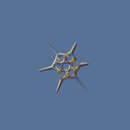Toxicity
provided by Harmful Phytoplankton Project
No direct toxic effects could so far be established. However, fish kills have occurred during D. speculum blooms and are thought to be due to oxygen depletion .
- bibliographic citation
- Guide to UK Coastal Planktonic Ciliates © 2001 DJS Montagnes, University of Liverpool http://www.liv.ac.uk/ciliate/
- author
- David J.S. Montagnes
Comprehensive Description
provided by Harmful Phytoplankton Project
This species can occur as a naked and a skeleton bearing form. The skeleton usually has 6 spines. Both the naked and the skeleton bearing stages are motile.
- Henriksen P, Knipschildt F, Moestrup O, Thomson, HA (1993) Autecology, life history and toxicology of the silicoflagellate, Dictyocha speculum (Silicoflagellata, Dictyochophyceae), Phycologia, 32(1), 29-39.
- Tomas C ed. (1996) Identifying marine diatoms and dinoflagellates. pp 598. Academic Press Ltd. London
- bibliographic citation
- Guide to UK Coastal Planktonic Ciliates © 2001 DJS Montagnes, University of Liverpool http://www.liv.ac.uk/ciliate/
- author
- David J.S. Montagnes
Distribution
provided by Harmful Phytoplankton Project
The species is cosmopolitan and found in cold and temperate waters, both coastal and oceanic
- bibliographic citation
- Guide to UK Coastal Planktonic Ciliates © 2001 DJS Montagnes, University of Liverpool http://www.liv.ac.uk/ciliate/
- author
- David J.S. Montagnes
Diagnostic Description
provided by Harmful Phytoplankton Project
Dictyocha speculum occurs in two growth forms: a naked, either mononucleated or multinucleated form and and a form bearing a silica skeleton. The skeleton of Dictyocha speculum has a regular and usually hexagonal shape although aberrant forms with incomplete rings and between 5-9 spines have been observed (Henriksen et al. 1993). The cells contain many yellow-brown chloroplasts.
- bibliographic citation
- Guide to UK Coastal Planktonic Ciliates © 2001 DJS Montagnes, University of Liverpool http://www.liv.ac.uk/ciliate/
- author
- David J.S. Montagnes
Brief Summary
provided by Harmful Phytoplankton Project
Dictyocha speculum and other members of the family Dictyochaceae are extremely variable in shape.
- bibliographic citation
- Guide to UK Coastal Planktonic Ciliates © 2001 DJS Montagnes, University of Liverpool http://www.liv.ac.uk/ciliate/
- author
- David J.S. Montagnes

